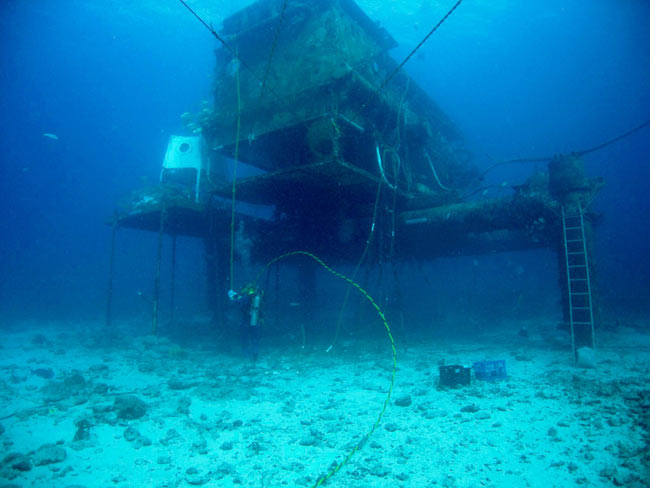NASA to Go Boldly to the Bottom of the Sea

Two astronauts, a veteran undersea engineer and anexperienced scientist will soon find themselves in the ocean depths off the eastcoast of Florida in a mock space mission to test exploration concepts and learnmore about working in an unforgiving, treacherous environment.
NASA on Tuesday announced the 14th expedition, which is partof NASA Extreme Environment Mission Operations, or NEEMO.The 14-day undersea mission is scheduled to begin May 10.
?Canadian Space Agency astronaut Chris Hadfield, a veteranspacewalker, will lead the NASA expedition to the Aquarius UnderwaterLaboratory, which rests more than 62 feet (18 meters) below the ocean's surfaceoff the coast of Key Largo in the Florida Keys.
The NEEMO 14 mission will use the ocean floor to simulateaspects of anotherplanet's surface and a low-gravity environment.
In October 2009, a team of aquanauts prepared for the NEEMO14 expedition by placing mockups of a lander, rover and small crane thatsimulates a robotic arm near the Aquarius laboratory.
Mock space mission ahead
The NEEMO 14 crew will live aboard the underwaterlaboratory, venture out on simulated spacewalks, operate the crane and maneuverthe vehicles in much the same way as astronautexplorers would in setting up a habitat on another planet.
Breaking space news, the latest updates on rocket launches, skywatching events and more!
As the aquanauts operate and test these developingtechnologies, they will provide information and valuable feedback to NASAengineers.
The crew is expected to simulate removing a mockup of the LunarElectric Rover from the lander, retrieve small payloads from the lander andthe ocean floor, and simulate the transfer of an incapacitated astronaut fromthe ocean floor to the deck of the craft.
The rover and lander mockups are comparable in size tovehicles that NASA is considering for future planetary exploration.
The lander mockup is wider than the entire length of aschool bus, and is almost three times as high. It measures 45 feet (13.7meters) wide and 28 feet (8.5 meters) high, including a 10-foot-high(3-meter-high) crane. The rover mockup is slightly larger than a full-size SUV,standing at approximately eight feet (2.4 meters) tall and 14 feet (4.3 meters)long.
Training for splashdown
Hadfield previously conducted two spacewalks and operatedthe International Space Station's robotic arm, known as Canadarm2, during thespace shuttle's STS-100 mission in April 2001. He also worked extensively withthe shuttle's robotic Canadarm on STS-74 in 1995.
Other team members include NASA astronaut and flight surgeonThomas Marshburn, Lunar Electric Rover Deputy Project Manager Andrew Abercrombyand Steve Chappell, a research scientist. Both Abercromby and Chappell work forWyle Integrated Science and Engineering of Houston, an engineering firm thatspecializes in aerospace, information systems and integrated science andengineering.
James Talacek and Nate Bender of the University of NorthCarolina at Wilmington are habitat technicians and will provide engineeringsupport.
While aboard Aquarius, the crew will perform life scienceexperiments that are focused on human behavior, performance and physiology. Themission also includes a study of autonomous crew work. In other words, therewill be periods when there is limited communication between the crew and themission control center, much like what could potentially happen during missionsto themoon or Mars.
The Aquarius laboratory is owned by the National Oceanic andAtmospheric Administration (NOAA) and is operated by the University of NorthCarolina at Wilmington.
- Visionsof a Moon Colony
- Images? Mars Base of the Future
- Mock MarsExplorers Gear Up for Simulated Mission

Space.com is the premier source of space exploration, innovation and astronomy news, chronicling (and celebrating) humanity's ongoing expansion across the final frontier. Originally founded in 1999, Space.com is, and always has been, the passion of writers and editors who are space fans and also trained journalists. Our current news team consists of Editor-in-Chief Tariq Malik; Editor Hanneke Weitering, Senior Space Writer Mike Wall; Senior Writer Meghan Bartels; Senior Writer Chelsea Gohd, Senior Writer Tereza Pultarova and Staff Writer Alexander Cox, focusing on e-commerce. Senior Producer Steve Spaleta oversees our space videos, with Diana Whitcroft as our Social Media Editor.
